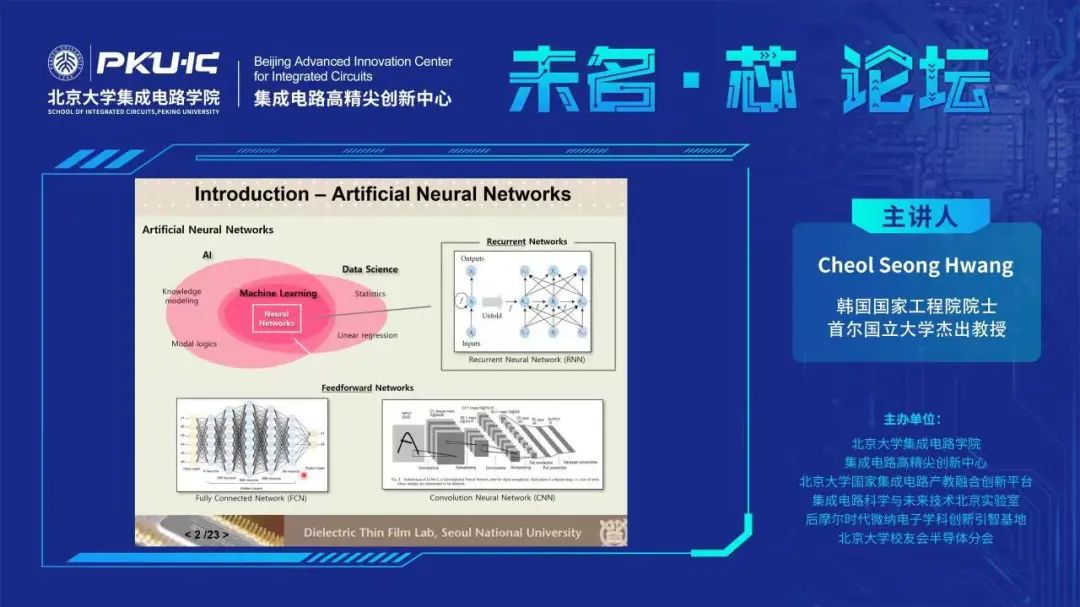12月22日上午9时30分,由北京大学集成电路学院、集成电路高精尖创新中心、北京大学国家集成电路产教融合创新平台、集成电路科学与未来技术北京实验室、后摩尔时代微纳电子学科创新引智基地、北京大学校友会半导体分会联合主办的“未名·芯”论坛系列讲座第十一期在线上成功举办。本期邀请到韩国国家工程院院士、首尔国立大学杰出教授Cheol Seong Hwang为大家带来主题为“Application of Passive Memory Array as a Physical Kernel for Time- Varying Data Analysis”的报告。讲座由北京大学集成电路学院杨玉超教授主持,60余人线上参加。

讲座伊始,Prof. Hwang通过传统的卷积神经网络,引入了“计算核(Kernel)”的概念。在卷积神经网络中,计算核起到了提取关键信息及压缩数据量的作用。同时,他也指出,传统的卷积神经网络计算核无法对时序信息进行有效处理,对于计算机算力也有较大的消耗和占用。为了解决这一问题,他提出了一种基于忆阻器阵列的物理计算核,其能够应用于储备池计算(Reservoir Computing)中,并且在功耗和速度上相较于同类结构都有较大的优势。
接着,Prof. Hwang讲到为了实现对于时序信息的处理,传统的硬件实现方法是使用易失性的忆阻器,通过信号的衰减和弛豫来表示不同的时序信号输入,但这一方法存在着时间常数受限、受器件间差异影响大的问题,无法适应不同信号频率的多种应用场景。因此,Prof. Hwang提出了基于非易失忆阻器的1M1R1C结构,利用电容的充放电过程来替代传统忆阻器信号的衰减。这一结构既消除了对于忆阻器一致性的要求,同时也使得电路能够适应不同外加信号的不同频率,简化了信号处理的过程,使得这一结构的应用场景得到拓展。Prof. Hwang以一组MNIST数据集上的测试结果为例,详细地介绍了这一结构。操作上来说,输入图像被分为4bit一组,通过上述时序编码的方式输入到196个神经元中,并通过全连接层产生结果。测试数据显示,这一结构不仅能保证90%以上的准确率,还比其他结构快1000~10000倍,并且由于计算核在网络结构中的独立性,可以通过调节计算核来优化网络的结算结果,充分展现了这一结构的应用潜力。
在应用层面上,Prof. Hwang以计算机辅助医疗诊断为代表,并以超声波和心电图两种诊断设备为例展示了该系统在时序信号处理中的应用。检测设备分别有着不同的时间常数,输出信号的频率也有所不同,但是由于上述计算核对不同时间常数信号的适应性,使得这一结构能够很好地完成对这两种信号的处理任务,并且相较于传统的诊断方法可以省去生成图像的步骤,直接将采集到的时序信号输入到忆阻器阵列中,通过全连接层即可得到诊断结果。
提问环节,线上观众积极踊跃,对电容加工的具体问题、计算结构的频率限制等方面进行提问,Prof. Hwang逐一进行了解答。
个人简介:
Cheol Seong Hwang received an M.Sc. degree in 1989 and a Ph.D. in 1993 in the department of inorganic materials science and engineering, both from Seoul National University-Seoul, South Korea. In 1993 he joined the Materials Science and Engineering Laboratory of the National Institute of Standards and Technology, MD USA, as a postdoctoral research fellow. Then, he joined Samsung Electronics as a senior researcher in 1994 and made contributions to the fields of semiconductor memory devices by researching high-k dielectrics, including (Ba,Sr)TiO3. Since 1998, he has been a professor in the materials science and engineering department at Seoul National University. He has authored or co-authored more than 676 papers in international peer-reviewed scientific journals, which are cited ~38,700 times (H-index 93), and has given over 100 invited presentations at international conferences. He also holds 183 (89 approved, 94 under review) international/domestic patents. He is a recipient of the Alexander von Humboldt fellowship award, which made him stay in Forschungszentrum Juelich, Germany as a Humboldt fellow in 2004, the 7th presidential young scientist award of the Korean government, and the AP Faculty Excellence Award, Air Products, USA, Inchon Award, and Kyung-Ahm Award. His current interests include high-k gate oxide, DRAM capacitors, new memory devices including RRAM/PRAM, ferroelectric materials and devices, negative capacitance effect, and thin-film transistors. He is also working actively in neuromorphic computing devices/materials. He served as the general chair of the international ALD conference in June 2010 in Seoul, Korea. He also authored “Atomic Layer Deposition for semiconductor” in 2013 through Springer and “Ferroelectricity in doped hafnium oxide” in 2019 through Elsevier. He is a member of the Korean Academy of Science and Technology, the National Academy of Engineering of Korea, and a Fellow of the Royal Society of Chemistry, UK. On September 1, 2020, he was selected as the Seoul National University (SNU) Distinguished Professor. In addition, he received the 2022 ALD innovation award from the American Vacuum Society.
技术文字 | 刘宇恒